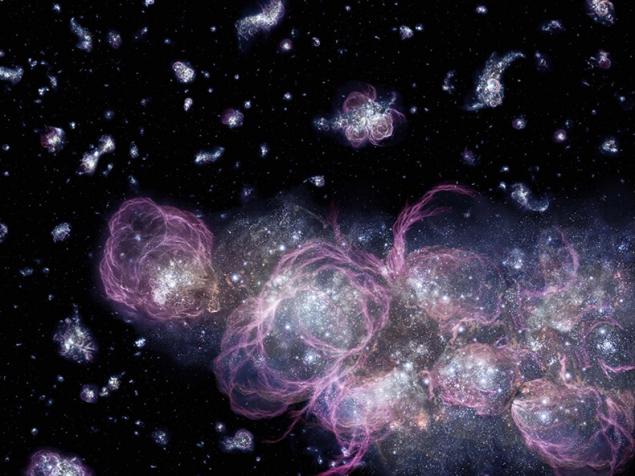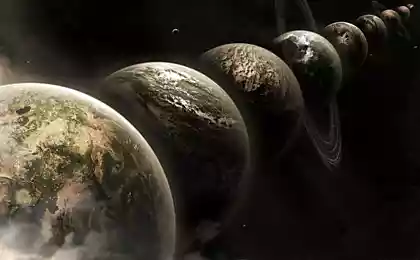571
Bridge from nowhere: is it possible to get something out of nothing
"The question of being is the darkest in all philosophy". So concluded William James, reflecting on the most basic of mysteries: how can something arise out of nothing? This issue is exasperated, decided James, because it requires explanation, denying the very possibility of its existence. "To go from nothing to being there is no logical bridge," he wrote.
In science explanations are based on cause and effect. But if nothing is actually nothing, it is not possible, cause. It is not that we can't find a proper explanation – just the face of "nothing" explanation doesn't work.
This refusal has affected area. We are creatures who love story. Our simple concepts come through history and how something came from nothing – this is the main story, a prehistoric novel, is more fundamental than the "hero's journey" or "boy meets girl". But this story undermines the essence of the story. This story is woven from self-destruction and paradox.

And how can she be like that? The main character is Nothing. The word paradoxical due to its very existence as a word. It is a noun, a thing, however, is not a thing. As soon as we give it to yourself or call it, we destroy the void, tainted by its value. It remains to wonder: is the problem with "nothing", or is it our problem? Space, or linguistic? Existential or psychological? The paradox of physics or thoughts?
However it should be remembered that the solution of the paradox is in the question, not the answer. Somewhere must be a failure, wrong guess, wrong identity. In this short question "how something came from nothing?" there are not many places to hide. Perhaps because of this, we keep going back to old ideas in a new shell playing at the development of science of the Fugue, or variations of the theme. With each pass we're trying to get another stone for crossing the river, extending elusive bridge James.
The oldest of the stones: if you can't get something from nothing, try to make nothing look so empty. The ancient Greeks believed that the empty space is filled with a substance, ether. Aristotle thought the air unchanging fifth element, more perfect than the earth, air, fire and water.
"Nothing" is contrary to Aristotelio physics, who claimed that bodies fall or rise according to their proper place in the natural course of things. Nothing has to be perfectly symmetrical to look the same from any angle, eliminating the sense of absolute spatial directions "top" and "bottom". The aether, according to Aristotle, could serve as a cosmic compass, a basic system of reference relative to which to measure all movement. For those who hated the vacuum, the air expelled him.
Ancient aether existed for thousands of years, until it was reinterpreted in the late nineteenth century physics, for example, James Clerk Maxwell discovered that light behaves like a wave, always moving with the same speed. What worried relative to what and measured the speed? The air was the easy answer, and provide the environment and a reference system. But when albert Michelson and Edward Morley set out to measure the motion of the Earth through the "ether wind" in 1887, they found the last. Soon Einstein and his special theory of relativity hammered the last nail in the coffin of the ether.
For decades, we believed the air historical curiosity, regress. But killing him was harder than we thought. Today it can be seen in a different form: the Higgs field penetrating the vacuum of empty space, excited by the famous Higgs boson. This scalar field, the only representative of its kind, confirmed experimentally. This means that in each point in space it has a single value (in contrast to the fields describing the light, which at every point is the size and direction). This is important because it means that the field will look the same for any observer, whether at rest or accelerating.
Moreover, its quantum spin is zero, that is, it looks the same from any angle. Spin – a measure of how much you have to turn the particle to make it look the same as before rotation. The carriers of interactions (photons, gluons) spin a 360 – degree turns will leave them unchanged. The particles of matter (electrons, quarks) are spin half-integer and, therefore, they need to rotate twice, 720 degrees, to return to the initial state. But the Higgs is spin zero. Like it or rotate, it always looks the same. Just like empty space. Symmetry equals invisibility.
According to the intuition of Aristotle, today's physicists believe nothing final state symmetry is a relentless self-similarity, prior to finding the differences required to define "things". If physicists run the cosmic film in reverse, tracking the history of the deep past, they see the Union of disparate fragments of reality, turning them into a growing symmetry, indicating the source – nothing.
Higgs became famous for the supply of elementary particles their mass, but this hides his real value. To give mass to particles is just. To slow their speeds below the light and mass. It's hard to give them mass, without breaking a prehistoric symmetry. The Higgs field achieves this by taking a nonzero value even in a state of least energy. In every corner of empty space shrunk 246 GeV Higgs – but we do not notice because it is the same everywhere.
Only a scalar field can hide in plain sight. But notice the elementary particles. Each time the mass of the particle breaks the symmetry of the Universe, the Higgs is there, disguised as an empty space, eliminates damage. Always working in the shadows, Higgs preserves the original symmetry of the Universe intact. You can understand (if not forgive) the tendency of journalists to use the name "God particle" – even if Leon Lederman, who coined a derogatory term, originally wanted to call it the "God damn particle" but his publisher wouldn't let him to do it.
All this means that the Higgs field is closer to nothing than Maxwell's concept of the ether. This is the newest of our brushes to paint in the void. With its unusual symmetry Higgs works as a disguise for nothing, but in itself it is nothing. It has structure, it interacts. The physical meaning of 246 GeV is unknown. With the Higgs we are approaching the limits of nothing, but are unable to cross.
If you attempt to do nothing so empty is not the answer to the question "how something came from nothing", we need to make the reason is not that the reason. And these attempts has its own history. The sudden appearance of maggots on rotting meat in the days of Aristotle led to the popular myth of spontaneous origin of life; the breath of life is able to arise from the void.
The boundary between nothing and something stood next to the border between life and death, spirit and matter, divine and earthly. In turn, this brought with it a whole set of religions and faith, giving rise to a very complex solution to our paradox. We have adopted this theory for 2000 years until in 1864 it was not dispelled by the microbiologist Louis Pasteur. Omne vivum ex vivo – all life from life. In subsequent decades we have found the spontaneous emergence of yet another historical curiosities. But, like air, she came back to us in sheep's clothing quantum fluctuations.
Quantum fluctuations, decorated with uncertainty, it is no effect without a cause, the noise in the signal, the primordial statics, random in nature. The rules of quantum mechanics allow – even require – that the energy (and, according to E=mc2, mass) appeared from nowhere, out of nothing. Creation ex nihilo, it looks like.
The Heisenberg's uncertainty principle is a natural source of quantum maggots. ["maggot" in English is not only the larva but also whim, whim, whim – approx.transl.] He posits that certain pairs of physical properties – position and momentum, energy and time is bound together with fundamental uncertainty. The more accurately we specify one of the options, the less clear becomes the other. Together they form related pairs and prevent the existence of "nothing".
Start to clarify the spatial position and the momentum will start wildly fluctuate. Define small and precise periods of time, and the energy starts to fluctuate in a wider span of unlikely values. In the shortest of moments on the shortest distances can suddenly entire universes arise and then disappear. Zoom in to the world, and the calm, structured reality gives way to chaos and randomness.
But these linked pairs themselves are not random: it is a pair of properties that an observer will not be able to measure at the same time. Although usually described as quantum fluctuations, in the world there is some pre-defined reality, arthusa back and forth. The experiment shows that what is, in fact, does not exist, and is waiting. Unborn. Quantum fluctuations is not existential, and conditional descriptions – they do not reflect what is, but only what would be possible if the observer decides to carry out a certain measurement. If the ability to measure the observer determines what is to exist. Ontology sums up epistemology. The uncertainty of nature is an uncertainty of observation.
The fundamental inability to assign definite values to all the properties of the physical system means that when the observer is measuring, the result will be truly random. On a tiny scale, ruled by quantum effects, the chain of cause and effect goes crazy. Quantum mechanics, as said its founding father Niels Bohr, "irreconcilable with the concept of causality". Einstein, as you know, ignored her. "God does not play dice," he said – to which Bohr replied, "Einstein, stop telling God what to do".
Maybe we should blame in anticipation of the preservation of the principle of causality. Evolution has taught us any price to look for simple patterns. For our ancestors, Russakovich the African Savannah, the ability to recognize the consequences of the reasons pointed the difference between life and death. She ate a spotted mushroom and got sick. The tiger crouches before jumping. Stories mean survival. Natural selection does not need the quantum physics so that we could have guessed its existence? But it does exist. And causality is an approximation. It is our consciousness looking for story.
And well, that's all? The answer to the question "why we exist" is that there is no "why" that existence is a random quantum fluctuation? Well, we can throw all sorts of explanations and to make the quantum leap to the bridge James. As something came out of nothing? Yes, just like that. Unfortunately, we will not get very far. Cosmologists believe that the laws of quantum mechanics can spontaneously create universes, this story is just passing the buck. Where did these laws? Remember that we wanted to explain how something came from nothing – and not how something came from pre-existing laws of physics. It is not enough to remove causality from the equation – the paradox remains.
In the beginning there was nothing and then something appeared.
The main character in this story is the Time a carrier changes. Can the solution to the paradox consist in the negation of time? If time, as Einstein said, only a persistent illusion, we can immediately be liberated not only from causality arising from the laws of nature, but the question is, where did these laws. They do not come from nowhere, because there is no evolution. The story disappears, there is no history there, and no bridge either.
The concept of an eternal universe, or cyclical, eternally returning, appear in the earliest myths and stories from the mythology of Bantu Africa before the Time of the dreaming of Australian aborigines, from cosmology Anaximander of Miletus to ancient Indian Puranas. You can see the appeal of these theories. Eternity avoiding "nothing".
In our time this ancient idea returned in the form of the theory of a stationary Universe, formulated by James jeans in 1920, and then refined and popularized by Fred Golam and others in the 1940s. the universe is expanding, but to fill the voids is all the time there is a new matter, therefore, on average, the universe does not change. Theory was incorrect, it was replaced by the Big Bang theory, and eternity was reduced to some 13.8 billion years.

But in the 1960s a stationary universe suddenly came back in a strange form in equation
H(x)|Ψ> = 0
Physics John Archibald Wheeler [John Archibald Wheeler] and Bryce DeWitt [Bryce DeWitt] wrote it, now known as the equation of the Wheeler-DeWitt, DeWitt even though he calls him "that damned equation" (no relationship with the "goddamned particle"). They tried to enforce strange laws of quantum mechanics to the Universe as a whole, as it is described in Einstein's General theory of relativity. You should pay attention to the right part of the equation is zero.
The total energy of the system – nothing. No evolution in time. Nothing can happen. The problem is that Einstein's universe is four-dimensional space-time, the combination of space and time. But quantum mechanics requires that the wave function of a physical system evolved in time. But how can spacetime evolve in time if it is time?
This dilemma just infuriates universe described by quantum mechanics, freezes in time. Equation Wheeler-DeWitt is the theory of a stationary Universe inside out. Instead of always existing Universe we have the universe, which never will be.
In itself the equation of the Wheeler-DeWitt elegantly solve our problem. Out of nothing came something? It did not appear. But this decision is puzzling – after all, we're here.
That's the point. In quantum mechanics, nothing happens as long as the observer (the person or other configuration of particles) makes the measurement. But in the case of the universe the observer does not exist. No one can stand outside the universe. The universe as a whole is stuck in an infinite moment. But inside everything looks different.
The inside observer cannot measure the entire universe, and therefore divides the reality into two parts, the observer and the observed is due to the simple but powerful fact that the observer cannot measure himself. As he wrote to physicist Rafael Bousso [between bousso Raphael], "Obviously, the device should not be less degrees of freedom than the system whose quantum state he is trying to tell." Philosopher of science Thomas brewer [Thomas Breuer] used Godlewski argument to Express the same thought: "No observer can obtain or store information sufficient to distinguish all States of the system in which it is located".
As observers, we are doomed forever to see only a piece of a large puzzle, which we are part. And it can be our salvation. When the universe splits into two parts, the zero in the right side of the equation is changed to another value. Everything is changing, the physics is happening, time goes by. You could even say that the universe is born.
If this sounds like retrocausality (the future affects the past) – well, the way it is. Quantum theory requires this strange treatment of time's arrow. Wheeler drew attention to this fact by using the famous delayed-choice experiment which was first proposed as a thought, and then was demonstrated in the laboratory.
How to determine the sign of the zodiac with an absolute accuracy of10 exercises for the brain, which stimulate the development of new nerve connections
In delayed choice measurement in the present of the observer determines the particle behaviour in the past – a past that can stretch back for millions and even 13.8 billion years. The chain of cause and effect, turns on itself, and its end connects with the beginning of the bridge James is a loop.
Could it be that something that looks like nothing from the inside? If so, then our concern about "nothing" may hint at a profound thought: our human nature abhors "nothing", and thus it is our limited perspective, and solves this paradox.published
Author: Vyacheslav Golovanov
Source: geektimes.ru/post/280648/?utm_source=tm_megamozg&utm_medium=tm_block&utm_campaign=tm_promo
In science explanations are based on cause and effect. But if nothing is actually nothing, it is not possible, cause. It is not that we can't find a proper explanation – just the face of "nothing" explanation doesn't work.
This refusal has affected area. We are creatures who love story. Our simple concepts come through history and how something came from nothing – this is the main story, a prehistoric novel, is more fundamental than the "hero's journey" or "boy meets girl". But this story undermines the essence of the story. This story is woven from self-destruction and paradox.

And how can she be like that? The main character is Nothing. The word paradoxical due to its very existence as a word. It is a noun, a thing, however, is not a thing. As soon as we give it to yourself or call it, we destroy the void, tainted by its value. It remains to wonder: is the problem with "nothing", or is it our problem? Space, or linguistic? Existential or psychological? The paradox of physics or thoughts?
However it should be remembered that the solution of the paradox is in the question, not the answer. Somewhere must be a failure, wrong guess, wrong identity. In this short question "how something came from nothing?" there are not many places to hide. Perhaps because of this, we keep going back to old ideas in a new shell playing at the development of science of the Fugue, or variations of the theme. With each pass we're trying to get another stone for crossing the river, extending elusive bridge James.
The oldest of the stones: if you can't get something from nothing, try to make nothing look so empty. The ancient Greeks believed that the empty space is filled with a substance, ether. Aristotle thought the air unchanging fifth element, more perfect than the earth, air, fire and water.
"Nothing" is contrary to Aristotelio physics, who claimed that bodies fall or rise according to their proper place in the natural course of things. Nothing has to be perfectly symmetrical to look the same from any angle, eliminating the sense of absolute spatial directions "top" and "bottom". The aether, according to Aristotle, could serve as a cosmic compass, a basic system of reference relative to which to measure all movement. For those who hated the vacuum, the air expelled him.
Ancient aether existed for thousands of years, until it was reinterpreted in the late nineteenth century physics, for example, James Clerk Maxwell discovered that light behaves like a wave, always moving with the same speed. What worried relative to what and measured the speed? The air was the easy answer, and provide the environment and a reference system. But when albert Michelson and Edward Morley set out to measure the motion of the Earth through the "ether wind" in 1887, they found the last. Soon Einstein and his special theory of relativity hammered the last nail in the coffin of the ether.
For decades, we believed the air historical curiosity, regress. But killing him was harder than we thought. Today it can be seen in a different form: the Higgs field penetrating the vacuum of empty space, excited by the famous Higgs boson. This scalar field, the only representative of its kind, confirmed experimentally. This means that in each point in space it has a single value (in contrast to the fields describing the light, which at every point is the size and direction). This is important because it means that the field will look the same for any observer, whether at rest or accelerating.
Moreover, its quantum spin is zero, that is, it looks the same from any angle. Spin – a measure of how much you have to turn the particle to make it look the same as before rotation. The carriers of interactions (photons, gluons) spin a 360 – degree turns will leave them unchanged. The particles of matter (electrons, quarks) are spin half-integer and, therefore, they need to rotate twice, 720 degrees, to return to the initial state. But the Higgs is spin zero. Like it or rotate, it always looks the same. Just like empty space. Symmetry equals invisibility.
According to the intuition of Aristotle, today's physicists believe nothing final state symmetry is a relentless self-similarity, prior to finding the differences required to define "things". If physicists run the cosmic film in reverse, tracking the history of the deep past, they see the Union of disparate fragments of reality, turning them into a growing symmetry, indicating the source – nothing.
Higgs became famous for the supply of elementary particles their mass, but this hides his real value. To give mass to particles is just. To slow their speeds below the light and mass. It's hard to give them mass, without breaking a prehistoric symmetry. The Higgs field achieves this by taking a nonzero value even in a state of least energy. In every corner of empty space shrunk 246 GeV Higgs – but we do not notice because it is the same everywhere.
Only a scalar field can hide in plain sight. But notice the elementary particles. Each time the mass of the particle breaks the symmetry of the Universe, the Higgs is there, disguised as an empty space, eliminates damage. Always working in the shadows, Higgs preserves the original symmetry of the Universe intact. You can understand (if not forgive) the tendency of journalists to use the name "God particle" – even if Leon Lederman, who coined a derogatory term, originally wanted to call it the "God damn particle" but his publisher wouldn't let him to do it.
All this means that the Higgs field is closer to nothing than Maxwell's concept of the ether. This is the newest of our brushes to paint in the void. With its unusual symmetry Higgs works as a disguise for nothing, but in itself it is nothing. It has structure, it interacts. The physical meaning of 246 GeV is unknown. With the Higgs we are approaching the limits of nothing, but are unable to cross.
If you attempt to do nothing so empty is not the answer to the question "how something came from nothing", we need to make the reason is not that the reason. And these attempts has its own history. The sudden appearance of maggots on rotting meat in the days of Aristotle led to the popular myth of spontaneous origin of life; the breath of life is able to arise from the void.
The boundary between nothing and something stood next to the border between life and death, spirit and matter, divine and earthly. In turn, this brought with it a whole set of religions and faith, giving rise to a very complex solution to our paradox. We have adopted this theory for 2000 years until in 1864 it was not dispelled by the microbiologist Louis Pasteur. Omne vivum ex vivo – all life from life. In subsequent decades we have found the spontaneous emergence of yet another historical curiosities. But, like air, she came back to us in sheep's clothing quantum fluctuations.
Quantum fluctuations, decorated with uncertainty, it is no effect without a cause, the noise in the signal, the primordial statics, random in nature. The rules of quantum mechanics allow – even require – that the energy (and, according to E=mc2, mass) appeared from nowhere, out of nothing. Creation ex nihilo, it looks like.
The Heisenberg's uncertainty principle is a natural source of quantum maggots. ["maggot" in English is not only the larva but also whim, whim, whim – approx.transl.] He posits that certain pairs of physical properties – position and momentum, energy and time is bound together with fundamental uncertainty. The more accurately we specify one of the options, the less clear becomes the other. Together they form related pairs and prevent the existence of "nothing".
Start to clarify the spatial position and the momentum will start wildly fluctuate. Define small and precise periods of time, and the energy starts to fluctuate in a wider span of unlikely values. In the shortest of moments on the shortest distances can suddenly entire universes arise and then disappear. Zoom in to the world, and the calm, structured reality gives way to chaos and randomness.
But these linked pairs themselves are not random: it is a pair of properties that an observer will not be able to measure at the same time. Although usually described as quantum fluctuations, in the world there is some pre-defined reality, arthusa back and forth. The experiment shows that what is, in fact, does not exist, and is waiting. Unborn. Quantum fluctuations is not existential, and conditional descriptions – they do not reflect what is, but only what would be possible if the observer decides to carry out a certain measurement. If the ability to measure the observer determines what is to exist. Ontology sums up epistemology. The uncertainty of nature is an uncertainty of observation.
The fundamental inability to assign definite values to all the properties of the physical system means that when the observer is measuring, the result will be truly random. On a tiny scale, ruled by quantum effects, the chain of cause and effect goes crazy. Quantum mechanics, as said its founding father Niels Bohr, "irreconcilable with the concept of causality". Einstein, as you know, ignored her. "God does not play dice," he said – to which Bohr replied, "Einstein, stop telling God what to do".
Maybe we should blame in anticipation of the preservation of the principle of causality. Evolution has taught us any price to look for simple patterns. For our ancestors, Russakovich the African Savannah, the ability to recognize the consequences of the reasons pointed the difference between life and death. She ate a spotted mushroom and got sick. The tiger crouches before jumping. Stories mean survival. Natural selection does not need the quantum physics so that we could have guessed its existence? But it does exist. And causality is an approximation. It is our consciousness looking for story.
And well, that's all? The answer to the question "why we exist" is that there is no "why" that existence is a random quantum fluctuation? Well, we can throw all sorts of explanations and to make the quantum leap to the bridge James. As something came out of nothing? Yes, just like that. Unfortunately, we will not get very far. Cosmologists believe that the laws of quantum mechanics can spontaneously create universes, this story is just passing the buck. Where did these laws? Remember that we wanted to explain how something came from nothing – and not how something came from pre-existing laws of physics. It is not enough to remove causality from the equation – the paradox remains.
In the beginning there was nothing and then something appeared.
The main character in this story is the Time a carrier changes. Can the solution to the paradox consist in the negation of time? If time, as Einstein said, only a persistent illusion, we can immediately be liberated not only from causality arising from the laws of nature, but the question is, where did these laws. They do not come from nowhere, because there is no evolution. The story disappears, there is no history there, and no bridge either.
The concept of an eternal universe, or cyclical, eternally returning, appear in the earliest myths and stories from the mythology of Bantu Africa before the Time of the dreaming of Australian aborigines, from cosmology Anaximander of Miletus to ancient Indian Puranas. You can see the appeal of these theories. Eternity avoiding "nothing".
In our time this ancient idea returned in the form of the theory of a stationary Universe, formulated by James jeans in 1920, and then refined and popularized by Fred Golam and others in the 1940s. the universe is expanding, but to fill the voids is all the time there is a new matter, therefore, on average, the universe does not change. Theory was incorrect, it was replaced by the Big Bang theory, and eternity was reduced to some 13.8 billion years.

But in the 1960s a stationary universe suddenly came back in a strange form in equation
H(x)|Ψ> = 0
Physics John Archibald Wheeler [John Archibald Wheeler] and Bryce DeWitt [Bryce DeWitt] wrote it, now known as the equation of the Wheeler-DeWitt, DeWitt even though he calls him "that damned equation" (no relationship with the "goddamned particle"). They tried to enforce strange laws of quantum mechanics to the Universe as a whole, as it is described in Einstein's General theory of relativity. You should pay attention to the right part of the equation is zero.
The total energy of the system – nothing. No evolution in time. Nothing can happen. The problem is that Einstein's universe is four-dimensional space-time, the combination of space and time. But quantum mechanics requires that the wave function of a physical system evolved in time. But how can spacetime evolve in time if it is time?
This dilemma just infuriates universe described by quantum mechanics, freezes in time. Equation Wheeler-DeWitt is the theory of a stationary Universe inside out. Instead of always existing Universe we have the universe, which never will be.
In itself the equation of the Wheeler-DeWitt elegantly solve our problem. Out of nothing came something? It did not appear. But this decision is puzzling – after all, we're here.
That's the point. In quantum mechanics, nothing happens as long as the observer (the person or other configuration of particles) makes the measurement. But in the case of the universe the observer does not exist. No one can stand outside the universe. The universe as a whole is stuck in an infinite moment. But inside everything looks different.
The inside observer cannot measure the entire universe, and therefore divides the reality into two parts, the observer and the observed is due to the simple but powerful fact that the observer cannot measure himself. As he wrote to physicist Rafael Bousso [between bousso Raphael], "Obviously, the device should not be less degrees of freedom than the system whose quantum state he is trying to tell." Philosopher of science Thomas brewer [Thomas Breuer] used Godlewski argument to Express the same thought: "No observer can obtain or store information sufficient to distinguish all States of the system in which it is located".
As observers, we are doomed forever to see only a piece of a large puzzle, which we are part. And it can be our salvation. When the universe splits into two parts, the zero in the right side of the equation is changed to another value. Everything is changing, the physics is happening, time goes by. You could even say that the universe is born.
If this sounds like retrocausality (the future affects the past) – well, the way it is. Quantum theory requires this strange treatment of time's arrow. Wheeler drew attention to this fact by using the famous delayed-choice experiment which was first proposed as a thought, and then was demonstrated in the laboratory.
How to determine the sign of the zodiac with an absolute accuracy of10 exercises for the brain, which stimulate the development of new nerve connections
In delayed choice measurement in the present of the observer determines the particle behaviour in the past – a past that can stretch back for millions and even 13.8 billion years. The chain of cause and effect, turns on itself, and its end connects with the beginning of the bridge James is a loop.
Could it be that something that looks like nothing from the inside? If so, then our concern about "nothing" may hint at a profound thought: our human nature abhors "nothing", and thus it is our limited perspective, and solves this paradox.published
Author: Vyacheslav Golovanov
Source: geektimes.ru/post/280648/?utm_source=tm_megamozg&utm_medium=tm_block&utm_campaign=tm_promo
Wood fireplace: the living fire for ECO-houses
Leo Babauta: What to replace harmful foods in your diet























